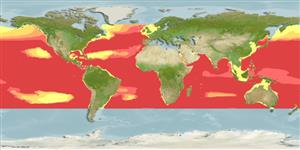Teleostei (teleosts) >
Stomiiformes (Lightfishes and dragonfishes) >
Gonostomatidae (Bristlemouths)
Etymology: Cyclothone: Greek, kyklothen, in circle, around (Ref. 45335).
Environment: milieu / climate zone / depth range / distribution range
Ecology
Marine; bathypelagic; depth range 16 - 4663 m (Ref. 58302), usually 600 - 1800 m (Ref. 58302). Deep-water; 61°N - 40°S, 180°W - 180°E
Atlantic, Indian and Pacific: in tropical to temperate waters. Southern Ocean: Indian Ocean sector south of Australia. South China Sea (Ref.74511).
Length at first maturity / Size / Weight / Age
Maturity: Lm 4.3 range ? - ? cm
Max length : 4.8 cm SL male/unsexed; (Ref. 5162); 7.5 cm SL (female)
Dorsal spines (total): 0; Dorsal soft rays (total): 12 - 15; Anal spines: 0; Anal soft rays: 16 - 19. Light to dark brown in color; transparent or slightly pigmented immediately anterior to anal and dorsal origin; median fin rays and internasal area pigmented; meningeal pigment extending to level of rear margin of eye (Ref. 3991).
Meso- to bathypelagic (Ref. 58302). Oceanic, precise depth range dependent upon developmental stage, latitude, season (Ref. 4769). Does not exhibit diel vertical migrations (Ref. 4769). Lipid content is 2.3 % in fresh body weight and wax ester is 34.0 % in total lipids (Ref. 9193).
Life cycle and mating behavior
Maturities | Reproduction | Spawnings | Egg(s) | Fecundities | Larvae
Gon, O., 1990. Gonostomatidae. p. 116-122. In O. Gon and P.C. Heemstra (eds.) Fishes of the Southern Ocean. J.L.B. Smith Institute of Ichthyology, Grahamstown, South Africa. 462 p. (Ref. 5162)
IUCN Red List Status (Ref. 130435)
Threat to humans
Harmless
Human uses
Fisheries: of no interest
Tools
Special reports
Download XML
Internet sources
Estimates based on models
Preferred temperature (Ref.
123201): 2.5 - 8.7, mean 4.2 °C (based on 3651 cells).
Phylogenetic diversity index (Ref.
82804): PD
50 = 0.5001 [Uniqueness, from 0.5 = low to 2.0 = high].
Bayesian length-weight: a=0.00389 (0.00171 - 0.00885), b=2.99 (2.79 - 3.19), in cm total length, based on LWR estimates for this (Sub)family-body shape (Ref.
93245).
Trophic level (Ref.
69278): 3.2 ±0.36 se; based on food items.
Resilience (Ref.
120179): Medium, minimum population doubling time 1.4 - 4.4 years (tm=3.5).
Fishing Vulnerability (Ref.
59153): Low vulnerability (10 of 100).
